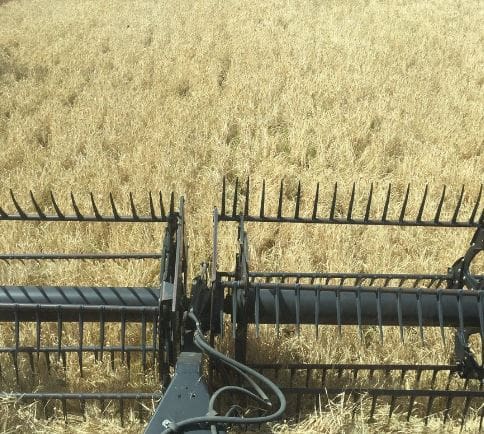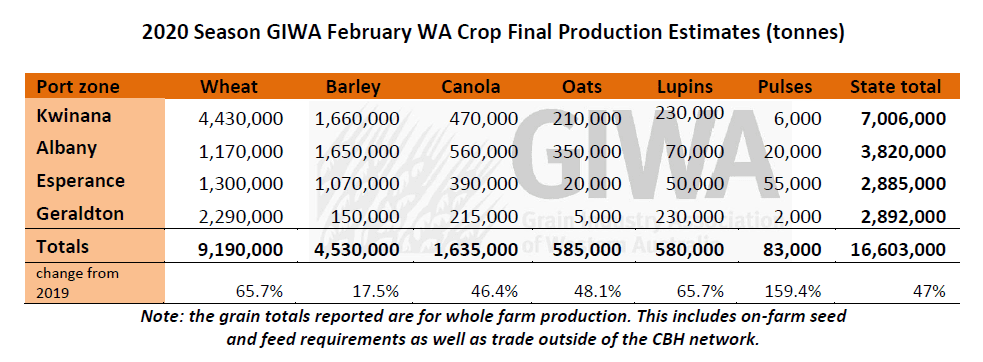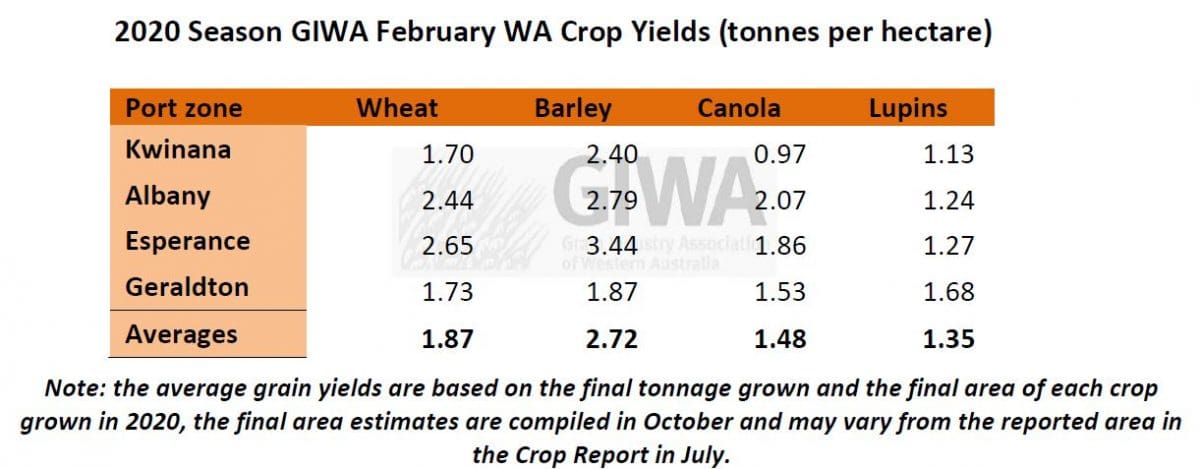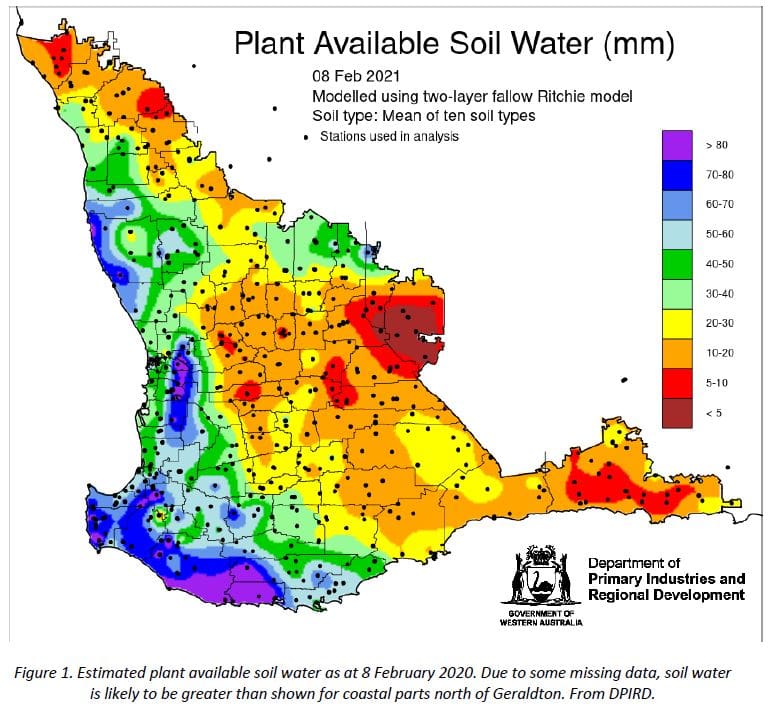THE most defining aspect around the 2020 Western Australian grain growing season was the 16.6 million tonnes (Mt) grown on very little rain, according to the Grain Industry Association of WA’s (GIWA) latest crop report.
 Many areas grew above average tonnage on well below average growing season rainfall.
Many areas grew above average tonnage on well below average growing season rainfall.
The total grain production in the state was a fraction behind 2013 (16.9Mt) and not far short of the record years of 2016 (18.1Mt) and 2018 (17.9Mt).
The result was exceptional considering the below average rainfall for most of the grain growing regions of WA.
Several factors came together over a large area to contribute to the result.
Minimal heat shock in the spring, timing of rainfall received, significantly less frost in the southern regions and the lack of waterlogging in the coastal and traditionally higher rainfall regions combined to return water use efficiencies in millimetres of rain per kilogram of grain production of nearly double the norm.
All crops benefited from the mild spring growing conditions as did grain quality.
Cereal screenings were high in some cases particularly for barley and there were some falling number problems for wheat in the western parts of the Esperance port zone.
Wheat grain protein was generally good, canola oil very good and many high yielding milling oat crops made Oat 1.
Lupin crops were a bit disappointing in the north and far south, although in the central regions grain yields were generally higher than normal.
Adequate tonnages of noodle wheat and malt barley were grown to fill demand.
More break crops
Grower production plans are being finalised for the 2021 growing season and the trend is towards more of the break crops such as canola and lupins being substituted for cereals in the rotation.
Oats are considered a break crop by many, particularly in wet and low frost prone areas, and with strong prices and demand for milling oats there is likely to be a slight creep up in area.
The exodus of sheep in the southern regions of WA has seen an increasing area of arable country sown to crops; this trend looks like it will continue.
There is also an increasing area of the high rainfall zones being sown to crops driven by the drier winters we have been having, resulting in less waterlogging; this trend also looks like it will continue.
This increased area of crops grown in WA combined with the rapid adoption of new technology has lifted WA’s “average” total tonnage produced to a solid 15Mt over the last 10 years.
Average barley grain yields exceeded average wheat grain yields in all zones in 2020 as it has in the past due to more wheat grown in the lower rainfall regions than barley.
Total barley area sown was down from the historical highs of the last few years, although barley continues to take area from wheat in the higher rainfall zones and in the south of the state.
Average canola grain yields for the state were close to the 1.52t/ha average which was produced in 2013.
This was short of the 1.76t/ha in the record production year of 2016 where 1.176 million hectares were grown. In 2020 there were approximately 1.1m hectares of canola planted.
The area planted to canola in WA is likely to rise in 2021 if there is an early break to the season or significant areas of summer rain.
Consistency of supply is never guaranteed in a rain fed production environment, but the ability of WA to continue to produce quality grain products for overseas customers was demonstrated again in 2020 and remains positive for the future.
Recent rainfall events across the northern and south western regions of WA have dropped useful quantities in some of the low rainfall regions which will act as a reserve in the spring this year.
Soil profiles are extremely dry as the 2020 crops were able to suck every millimetre of rain out of the ground due to the slow grain fill period.
Growers across the state will be hoping for more cyclonic activity to further top up soil profiles with moisture over the next few months.
The total area planted to crop in 2020 was about 8.5m hectares, this was the highest area on record.
This trend to more crop is likely to continue in 2021 as sheep numbers continue to decline and the shift to more cropping in the higher rainfall zones continues.


In reference to the above crop yields table, oat average grain yields have been omitted due to total area of oats sown being confounded by split into grain and hay. The pulse area is very small and has been left out as well as averages are unrepresentative of regional performance.
Zone-by-zone
Geraldton Zone
Most areas of the Geraldton port zone received the same effective total rainfall in 2020 as 2019. The major difference being timing of rainfall. In 2019, most of the rain fell early in the growing season in several intense events. In 2020, the rainfall was spread over the winter in “just in time” moderate events with the final rain in early August being the last useful rain for the year. In 2020, there was 2.892mt grown in the Geraldton port zone, a nearly 50 per cent increase in total tonnage over the 1.391mt grown in 2019, this was simply due to the timing of rainfall and the mild finish to the season.
Once again, the ameliorated soils shined above of the non-ameliorated soils. Deep ripping, spading and liming have transformed these soils and have improved the ability of crops to access moisture deep in the profile in spring in these northern environments.
The rapid crop growth from the warm winter in 2020 helped crops push through their growth stages faster than normal and this helped considering the end of May break to the season. All crops except lupins exceeded expectations in final grain yield. For lupins, crops were flowering later than is ideal and the heat got the better of them before they could set pods.
The water use efficiency of crops in the zone has been creeping up over recent years and is now about double what it was 20 years ago due to advancements in farming practices including soil amelioration, variety adaptation and more strategic crop type selection for the soil types.
The region received useful rains in early February with falls closer to the coast of 50 to 60mm graduating down to 20 to 30mm further east. These falls will get the summer weeds up that will need spraying and, in some cases, provide sub-soil moisture for crops to access during the growing season. The break crop area is likely to increase in 2021. Growers have been backing off on their appetite for dry sowing due to the damage from wind in the last few years and are less likely to sow canola and lupins dry early in the season than has been the case up until now. The area of break crops relative to cereals could swing widely this year based on when the break occurs.
Kwinana Zone
Kwinana North Midlands
Cereal crops in the region finished up yielding 20 to 30 per cent better than expected based on pre-harvest assessments. The head and grain counts were saying “yes, this is going to be good”, although experience suggested the grain yields could not hit those levels; the counts proved correct. The dry soil profile, lack of spring rain and later start meant any heat shock would cause crops to crash. But with mild spring conditions, this did not happen and yields of all crops ended up hitting or exceeding what the pre-harvest assessments suggested they would be.
Fast early crop growth, little frost and mild spring temperatures allowed crops on the medium textured and deeper soil types to fully utilise any rain that fell. The difference in grain yields from the very heavy soils in the northern areas and eastern areas of the region were vastly different to the remainder of the region. The wheat grain yields in the North Midlands on the heavy country struggled to hit 1.5t/ha and many went 1.0t/ha.
The western areas of the zone on the lighter country picked up some useful falls of rain in August. Adding to the rain, mild conditions and an extended grain-fill period resulted in achieving above average yields. The eastern areas of the zone bordering the Kwinana North East zone received the good falls of summer rain and grain yields here were well above average for all crops.
Barley mostly went to feed due to high screenings and growers dropping specialist malt varieties such as Bass, continuing the trend of “growing barley for feed” rather than malt which has been occurring in the rest of the state for some time.
Canola and lupin crops went well as did the oat hay crops. If pricing holds up closer to the start of the 2021 season, slight increases in area of these crops, in particular canola is likely.
Kwinana South
All crops in the region exceeded expectations by 10 to 20 per cent and in central areas of the zone where it was very dry, grain yields were closer to 30 per cent higher than expected. Soil type had a big influence on final grain yield as it did across most of the state. The better loam soils were well ahead of the two extremes of very light and very heavy soil.
Water use efficiencies were some of the best recorded over a large area of the zone with wheat yielding 1.4 to 1.6t/ha on 125 to 135mm of growing season rainfall backed up by residual moisture from falls of 50 to 60mm received over the previous summer. Grain quality was also good with screenings lower than expected. Wheat grain protein was also good with many loads making the premium grades.
The eastern portion of the zone included areas which received more summer rain and grain yields were above average. In the centre of the zone, grain yields were below average and for some growers well below average. Growers in the far western areas had their “best year ever”.
The area sown to barley in 2020 ended up being 20 to 30 per cent down on previous years due to uncertainty around export markets. Barley performed well compared to wheat in 2020 and with barley remaining an important part of rotations, further adjustments down in area are likely to be minimal.
The indication for the 2021 growing season is for a general increase in the area of canola and lupins as growers try to increase the area of break crops in their rotation.
Kwinana North East
For growers in the northern and eastern Kwinana zones that received good falls of summer rain, grain yields were very good for all crops. The region had some of the best best yields they have had for some time. Grain yields fell away dramatically north and east of these good areas and some growers had a year they would prefer not to remember.
Generally, though, the tonnage produced in the region was above average. For most growers in the region, wheat yields were better than expected and with strong prices, it ended up being a “good” year.
The better, deeper loams performed well with the heavy soils falling away sharply as they typically do in low rainfall years. Unsurprisingly, paddocks that had been fallowed went well compared to those in continuous wheat. Moving to areas with less growing season rainfall, fallow helped to maintain grain yields.
Rain was received in January and February in some areas in the zone, and whilst needing to spray summer weeds out is an extra cost, the benefit is more confidence going into the new cropping year from having some sub-soil moisture in the profile.
Albany Zone
Albany West
The West Albany zone had an exceptional year and even growers who are still getting the hang of being a ‘serious grain grower’ did well. The lack of waterlogging was the single biggest factor that impacted on the very high grain yield achieved in the region.
Barley and canola crops returned the best paddock averages for growers ever. Grain yields were well above what was thought prior to harvest, in part due to the region never having had a season like 2020 since cropping took off in the region 20 or so years ago.
The move to earlier planting using soil wetters has given growers confidence that they can get crops out of the ground on low rainfall events and due to the cooler climate, once up, crops rarely fail to survive a dry spell. This change in practice for the region has a two-fold effect of getting crops established early to better combat waterlogging and lengthens the growing season, giving higher grain yield potential. Frost can still be the elephant in the room, although strategic crop type selection has helped to minimise this.
Albany South
Barley and canola crops were very good to exceptional. Barley crops out yielded wheat by 0.5t/ha to 2.0t/ha. The practice of delaying the sowing of wheat to mitigate against frost risk effectively puts a cap on the length of growing season whilst barley sown earlier has more time to set up higher grain yield potential.
The season-saving rain in August and lack of waterlogging had the biggest impact on the final tonnage. There were still areas of frost in eastern parts and whilst nowhere near as bad as in recent years, frost still caused significant yield loss in some crops.
Canola crops benefited from the long grain fill period with biomass bearing no relation to eventual grain yield, highlighting the plasticity of this species. Some crops were short with the main stem contributing to the bulk of the yield, whilst other crops looked more typical with higher biomass equating to higher yield. The hybrid TT canola varieties are performing on par now with the best hybrid RR varieties, with many growers wanting to transition out of OP TT varieties if they can obtain seed for their preferred varieties.
Water use efficiencies for barley reached 29kg/ha/mm of rain, and canola 14kg/ha/mm of rain which is previously unheard of in these areas.
Lupins were generally disappointing ONLY yielding around 1.5t/ha.
Albany East (Lakes Region)
Most growers in the region “got out of jail” with the mild finish to the season considering the lack of growing season rainfall. There was a distinct cut-off at about 160mm of growing season rainfall where above this there was profit and below this a loss. The poorer areas were around parts of Hyden, Kalgarin, Pingaring and down to Lake Grace where only 130 to 140mm of growing season rainfall fell. The better areas were closer to Kulin and further west.
Actual grain yields were well up on pre-harvest estimates as no-one thought it was possible to reach the yields that the pre-harvest head counts suggested. The grain yield difference between barley and wheat was greater than normal with barley out yielding wheat by more than 0.5t/ha at yields around 2t/ha. Barley area was down a little due to grower reaction to the introduction of tariffs in China, although most who pulled back on barley will be back in the game this year as the crop has natural adaptation in the region and the new varieties have outpaced wheat in recent years.
Grain proteins were down due to the extended time to fill grain. Cereals sown on the previous year’s pastures struggled more than paddocks with mostly applied nitrogen, possibly due to the lack of rain limiting the amount of mineralized nitrogen available to the crops sown following pasture.
Due to highly variable soil types, there is less country deep ripped in the region compared to areas further north of the state in other port zones. Ripped soils generally out yielded similar unripped soils by 0.5t to 0.6t.
Canola went well after several years of bad press in the region and on reflection even in the run of low yielding years profitability has been reasonable and if prices remain firm, it is likely that there will be a swing back into canola in the zone.
Oat area is likely to be up in 2020 as well based on current pricing.
Sheep numbers continue their march south and with the lack of surface run-off to fill dams, that is likely to continue.
Esperance Zone
For the Esperance port zone, it was a similar story to the rest of the state with grain yields exceeding expectations by a fair bit. The better crops were on the better soil types, ameliorated country was better than the non-ameliorated country, and there was little frost except in the south western areas of the zone. The final rainfall event for the growing season in August also had a big impact on final grain yield.
The western regions of the zone had a welcome return to average and above average grain yields and for some areas the total tonnage produced was the highest for a very long time. The rain at the start of harvest caused a few problems with grain quality. Falling numbers in wheat dropped off where there were repeated rainfall events, although not as much as most would have thought. Growers commented that this may be due to the weeding out of the more susceptible varieties over time and it also may have been in part due to the timing of the rain in relation to the maturity of the wheat. Grain protein was “all over the shop”, with time of sowing, variety, rotation, applied nitrogen and yield not always explaining the result. The stop-start type of season seemed to have impacted on the wheat more than the barley; this was a reoccurring pattern across the state.
The difference in barley grain yields over wheat was greater than it has been in the past. This was very evident in the areas that received less August rain. Canola went well, particularly the hybrid TT’s. The move away from Bonito has not only avoided a black-leg pandemic for the region, but it has also lifted the top end grain yield potential. The less determinate nature of the good new Hybrid TT’s has allowed the crop to “match the season” by more aggressively foraging for moisture and nutrients when things are tight and then kicking on at the end if the moisture profile gets a top-up.
Peas, beans, lentil and lupins were disappointing. The reasons are varied, crop specific and more than can be listed here. For peas in general, it was mostly due to the regions they were grown in being the drier portions of the zone. For beans, just not enough rain being a much higher water user; for lentils, disease; and for lupins, flowering too late to hit high yield levels.
Sheep continue to be moved out of the zone due to the lack of surface run-off to fill dams and the good prices making it easier to part with them.
Season Outlook, February 2021
The WA Department of Primary Industries and Regional Development’s Ian Foster said after a growing season that delivered well below average rainfall, often around decile 2 or lower, WA grain production looked to be much better than expected earlier.
Stored soil water was limited for much of the season, and crop performance depended on timely rain events.
While spring frosts did occur, they were less frequent than average, and daytime temperatures were relatively mild. Growing season temperatures overall were above average by about one degree Celsius.
Major climate drivers were a La Niña event that developed later in 2020 and has reached its’ peak. The event is expected to decline through autumn 2021.
La Niña events do not traditionally have a strong impact on WA winter and spring rainfall, unlike eastern Australia.
The Indian Ocean Dipole (IOD) flirted with positive values in 2020 (these can suppress WA rainfall, as in 2019) but relaxed back to neutral late in 2020.
The Southern Annular Mode (SAM) in contrast had an impact on temperatures along the WA west coast over summer.
The SAM has been in its positive model over summer, in which westerly winds are further south than normal. A consequence of this is enhanced easterly winds.
Combined with lingering dry conditions from 2020, desiccated vegetation and generally dry soils, the bushfire risk was enhanced for the west coast and mid-west of WA.
Most climate models are indicating the next three months are more likely to be wetter than normal over most of WA.
Major climate influences for southern WA are the spill-over of tropical activity from northern Australia, combined with warmer than normal sea surface temperatures to the north and north-west of WA.
This has brought significant rain to north-western and southern WA in early February. See Figure 1 below for estimated soil water storage as at 8 February 2021.

Bureau of Meteorology seasonal outlook summary, issued 4 February 2021:
- February rainfall is likely to be above average in much of the southern two-thirds of Western Australia, north-east Queensland and parts of south-east Australia, but drier than usual from the top end to southern South Australia.
- February to April rainfall is likely to be close to or above average for much of Australia. Highest chance of above average rainfall likely in Western Australia, across the north-eastern tropics and parts of south-east Australia.
- Maximum temperatures for February to April are likely to be above average for most parts of Australia’s coastline, Queensland, and across Tasmania, and below average from north-west to south-east Western Australia.
- Minimum temperatures for February to April are very likely to be above average across most of Australia, and close to average in south-east Western Australia and western South Australia.
- La Niña is underway in the tropical Pacific. While the event is likely past its peak strength, it is still expected to influence Australia’s rainfall during this outlook period. La Niña typically increases the likelihood of above average rainfall across eastern and northern Australia during summer and early autumn months.
Additional information is available from: DPIRD: Seasonal Climate Information DPIRD: Soil Water Tool BoM: Seasonal Rainfall Outlook – weeks, months and seasons. BoM: Decile rainfall for April to October 2020 BoM: Seasonal Outlook video BoM: Landscape soil water balance
Source: GIWA

HAVE YOUR SAY